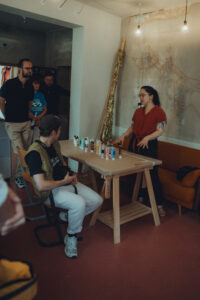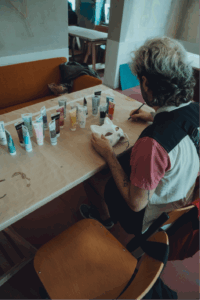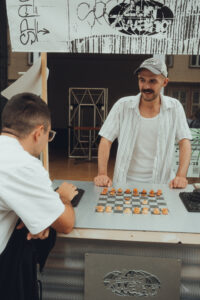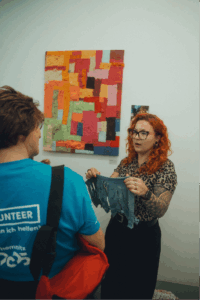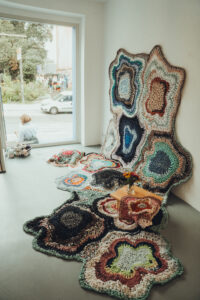- 14.08.2025 Review dialogue field 3Dialogfeld 3From train compulsion and trickster parades
The third round of the Dialogue Fields residency programme came to a close with an intensive week of intervention. From 11 July, artists Philipp Kolychev (Prague) and Denise Lee / 李筑 (lǐ zhú) (USA / Hong Kong / Taiwan) lived and worked on the Sonnenberg in Chemnitz. For Philipp Kolychev, the residency on the Sonnenberg became a playful experiment between chess, food and city life. With his mobile installation “ZugZwang”, he combined a chessboard, bread pieces and everyday street life to create an unusual experience. Passers-by could play against each other – and then eat the pieces they had captured. A game of strategy thus became a moment of exchange, a small shared meal and a friendly disruption to everyday life.
Philipp posed questions about hospitality, access to public space and the small rituals of everyday city life. At the same time, his cart was reminiscent of street vendors around the world – often inconspicuous, but central to urban life. Humorous and accessible, it encouraged people to question their own perception of the city and community.
Denise Lee also focussed on direct encounters. In her mask-making workshops, she created trickster masks inspired by mythical figures that symbolise change, cunning and social transformation. At the final trickster parade, the masks were carried through the streets of Chemnitz – a celebration of transformation, collective creativity, humour and the power of stories.
Anne Schädlich
From trash to treasure
As part of the third field of dialogue, Anne Schädlich further developed her artistic practice and made it visible. She focussed on the creative process: sewing, painting, crocheting or building, she processed impulses from everyday life – without ready-made plans, but with a great deal of experimentation and spontaneity.
During her six weeks, Anne collected found objects and donated items of clothing from the neighbourhood. These textiles were used to create large-format carpets and two-dimensional works that carried the stories of the city and its people. Old fabrics were given new value, their traces told of lives lived and became visible anew in the artistic work.
Anne invited visitors to discover these newly created surfaces, to engage with their own perspective and to ask questions: What constitutes the value of materials? Which stories remain, which are lost? Her works were both aesthetically impressive and provided inspiration for a more conscious approach to resources, memories and encounters.

